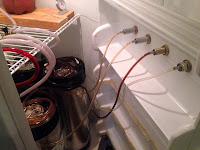I went to Costco and bought 4 gallons of 100% fresh pressed, albeit pasteurized, apple juice. I also bought 1.5 gallons of cranberry raspberry juice blend (again, 100% juice). It is important to note that neither of these juices had any sodium-based preservatives in them, and if you're planning on making your own cider, make sure you also get juice without preservatives. Your yeast may not propagate if the juice has preservatives in it.
Although I could have used only apple juice, I thought that the tart and sweet flavor of the cranberry raspberry juice would give the cider a nice flavor profile. Feel free to experiment, however! Think of the apple juice as the canvas and the other juice(s) as the paints.
 | |
| In the secondary fermenter |
- 6-6.5 gallon sanitized fermenting bucket or carboy for primary fermentation
- 5 gallon sanitized carboy for secondary fermentation
- 5-5.5 gallons of juice
- 3-5 lbs. of white table sugar (your resulting beverage will be 7-12 % alcohol, depending on how much sugar you use). If you'd like a very low alcohol cider, you can just not add any sugar at all; your resulting beverage should be around 3-4% alcohol.
- Wyeast 4766, Cider Yeast
- Sanitized racking equipment
- Yeast nutrient, if adding more than 3 lbs. of sugar (add 1 tsp per gallon of juice).
- Heat one gallon of juice until it is warm enough to dissolve the sugar in it. Do not boil the juice.
- Stir in your desired amount of sugar until it is completely dissolved.
- Mix the sugar/juice mixture and yeast nutrient (if needed) into your sanitized primary fermenter with the rest of the juice.
- Allow the mixture to reach room temperature and then pitch your yeast.
- Place the cider out of direct sunlight in an area that is between 60*F and 70*F. Allow to ferment for 2 weeks.
- Siphon the cider into the secondary fermenter (do not use your mouth to siphon, as you will probably contaminate the cider with bacteria). Allow to ferment in the same area for another 2 weeks.
- Bottle or keg the cider. Drink and be merry!









